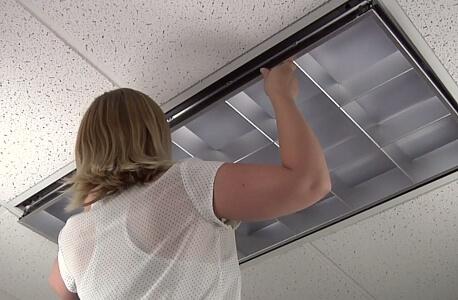While there are many medications to treat migraine pain, or reduce the frequency of episodes, medical intervention alone is unlikely to prevent them. Doctors commonly advise people living with migraines to avoid their migraine triggers, the environmental stimuli that send symptoms into overdrive.
In this article
- Migraine Symptoms Diagnosis
- Light Sensitivity & Migraines
- Adjusting Your Screen
- Digital Eyestrain
- Alternative Lighting
- Products to Stop Lighting Migraines
- Sound as a Trigger
- Stress as a Trigger
- Odors as a Trigger
- Employers Responsibility
It can take a fair amount of trial and error to identify migraine triggers. Many people living with migraine pain eventually realize their episodes are triggered by the stress, noise, odors, or artificial lighting they encounter at work. Once triggered, migraine symptoms can hinder productivity, interfere with work quality, or keep you on the sidelines.
If you are one of the many migraineurs exposed to migraine triggers at work, a few simple modifications could reduce their impact. Minimizing the impact of your triggers could reduce the frequency or severity of your migraine symptoms.
Too Many Migraineurs are Undiagnosed
A migraine is more complex than a simple headache. Researchers commonly believe that migraines are caused by the over-reaction of the central nervous system to certain stimuli. For those living with chronic migraine, it’s important to avoid the circumstances that trigger “irrational” neurological responses.
More than half of those affected by migraine pain are undiagnosed. Since the signs and symptoms of migraines are different for everyone, many people don’t recognize the symptoms. Instead, they blame stress, fatigue, or eyestrain for their discomfort.
While headaches are the most commonly discussed migraine symptom, they are not the only sign of this potentially debilitating disorder. Consider consulting with your doctor if you experience two or more of the following symptoms:
- Moderate to severe head pain lasting 4-72 hours
- A headache that intensifies with activity
- Difficulty concentrating or processing information
- Sensitivity to light, sound, odors, or certain foods
- Nausea or vomiting
- Blurred vision, vision loss, or visual disturbances
- Facial numbness or tingling
- Difficulty speaking
- Dizziness or vertigo
- Digestive disturbances
Chronic migraine is the 12th leading cause of disability in the US. For those living with migraine pain, the debilitating symptoms eventually subside, but the threat of triggering the next episode is always present. There will always be a next time.
Identifying Your Workplace Triggers
Migraine symptoms are often triggered by situations that would not ordinarily cause headaches in others. Once relatively common factors trigger an episode, the pain can be relentless.
Workplace triggers are often difficult to identify because it can take several hours (6-8) for symptoms to escalate. Sometimes the trigger is influenced by a combination of factors rather than a single stimulus. In the workplace, many migraineurs find their attacks can be triggered by:
- Stress or anxiety
- Muscle tension or poor posture
- Odors from perfume, cleaning supplies, or air fresheners
- Hunger or dehydration
- Loud or persistent noise
- Digital eyestrain
- Fluorescent lights
Once a migraine is triggered, you may have little choice but to wait it out in a dark, quiet room until symptoms subside. Since workplace migraines can result in reduced productivity and lost wages, workplace accommodations to minimize triggers are beneficial to migraine sufferers and their employers.

Migraineurs Are Prone to Light Sensitivity
Nearly 90 percent of those living with migraine are sensitive to harsh lights. Researchers at Beth Israel Deaconess Medical Center and Harvard Medical School investigated the connection between light-sensitive nerve cells and migraine. During their research, they discovered previously unidentified connections between nerve cells in the retina and neurons extending to various regions of the brain.
Test subjects with a history of migraine were affected by different colors of the light spectrum. Those who did not experience migraines were not. Consider the following observations:
- All colors of the visible light spectrum triggered unpleasant sensations during and between attacks
- Migraine sufferers reported intense negative emotional responses to all light colors except green
- Participants not affected by migraines did not experience unpleasant physiological sensations from light
- Those not affected by light reported pleasant emotions from all colors of the visible light spectrum
Researchers found that the nerves relaying signals from the eye to the brain played a significant role in migraine symptoms. Those living with migraine pain were most sensitive to blue light, the color of the light spectrum commonly emitted from fluorescent lights and computer screens.
While light sensitivity is both a migraine trigger and a symptom, for many people, it’s the flicker of computer screens and fluorescent lights that triggers migraine pain.
Simple Modifications Can Minimize Migraine Triggers
If your migraines are triggered by lack of sleep, certain foods, hunger, or dehydration, avoiding your triggers is pretty straightforward. When your migraines are triggered by noise, smells, computer screens, or fluorescent lights, avoiding your triggers can be challenging, particularly while you are working.
Identifying your migraine triggers, and finding workable solutions, can help you create a migraine-friendly workplace. To help manage workplace triggers, consider the following suggestions.
Modifying the Output of Your Screen

Spending hours every day focused on a computer screen can be detrimental to those who are sensitive. Research suggests that 14 percent of people living with migraines are triggered by computer screens. Some believe that number could be higher. These simple modifications could minimize the impact of computer screens on your migraine symptoms:
-
Adjusting Screen Brightness
When your computer screen is the brightest light in the room, the contrast forces your eyes to adjust to multiple light sources. Continuous visual adjustments contribute to eye strain. Reducing the brightness of your screen softens the contrast. Adjust the brightness of your computer screen to a lower setting.
-
Adjusting the Refresh Rate
Like fluorescent lights, computer screens have an imperceptible flicker. You could reduce your risk of triggering a migraine by adjusting the refresh rate of your monitor. Go into your settings to modify the refresh rate. You will find your refresh rate options in “preferences.” Select the “advanced” setting found in “display properties” and select a higher number. You will see the refresh rate specified in Hertz.
It may also be beneficial to consider the placement of your computer monitor. Your computer screen should be located comfortably in front of you. Make any necessary adjustments so you don’t need to slouch or strain to do your work. You may also want to consider using a larger font size or an anti-reflective filter on the screen to minimize glare.
Minimize Your Risk of Digital Eye Strain
Changing the output of your computer screen will help reduce the impact of migraine triggers by altering the input to your brain. It may also be helpful to consider the potential impact of viewing the screen on your eyes. Even for people who do not experience migraines, computer screens, tablets, and cellphones cause digital eye strain and headaches.
When focusing intently on a screen, you will likely blink 65 percent less than when your eyes are relaxed. The repetitive motion of your eyes can strain the muscles that control eye movement and focus. The combined effects can result in blurred vision, irritation, and light sensitivity. To minimize the migraine-triggering effects of digital eye strain, consider the following suggestions:
- Make a conscious effort to blink more often to help keep your eyes moisturized and comfortable
- Take frequent breaks from focusing on your screen by focusing on a distant object for 20 seconds every 20 minutes
- Use artificial tears to counteract dryness or irritation
- Keep your body hydrated to help keep your eyes moisturized
- Invest in an anti-reflective coating if you wear glasses
- Position your computer screen parallel to windows to minimize glare
Even if you have never worn glasses, it’s important to remember that vision can change over time. Uncorrected vision problems including nearsightedness, farsightedness, and astigmatism can increase your risk of developing digital eye strain.
Invest In an Alternate Light Source
While this solution may not be practical in every workplace, if you have your own office, turn off the fluorescent lights or consider turning off a bulb or two within the lighting fixture. Reducing the amount of fluorescent light in your immediate work area will reduce your overall exposure and minimize your risk of a fluorescent light headache.
In place of overhead light fixtures, consider using a desk lamp or floor lights with these migraine-friendly suggestions:
- Invest in full-spectrum light bulbs that closely mimic natural sunlight
- Use incandescent bulbs to reduce the amount of flicker in your immediate area
- Look for a desk lamp with adjustable brightness levels
- Consider a maneuverable arm allows you to control the angle and direction of the light
- Invest in a floor lamp with a mobile base
Many people who are sensitive to fluorescent lights consider LED bulbs a logical solution. It’s important to know that LED’s have a greater fluctuation rate than even fluorescent bulbs, essentially turning off and on hundreds of times per second. While LED lights can be good for the planet, many migraine patients find that LED’s also trigger migraine pain.
Install Fluorescent Light Filters
A fluorescent light filter fits over an existing fluorescent light fixture to eliminate glare and tone down the harshness of fluorescent lights. The best fluorescent filters also block UV rays and transform the color temperature to a soft, comfortable white light closer to natural sunlight.
While many migraineurs find they can experience fewer migraines when fluorescent light is filtered, coworkers may also take notice of the benefits. Fluorescent light filters can improve the workplace environment by:
- Reducing eyestrain and headaches caused by glare and light temperature
- Reduce the symptoms of anxiety that can be triggered by fluorescent light
- Improve workplace concentration and focus
- Minimize the sleep cycle dysregulation caused by high energy light
UV filtration is a significant feature to look for when investing in fluorescent light filters. Exposure to indoor ultraviolet light can increase your risk of eye disease by up to 12 percent. The lighter your eye color, the more susceptible your eyes could be to UV damage.

Wear Noise Canceling Headphones
Sound sensitivity is also a common migraine trigger. While many people realize they are sound sensitive during a migraine attack, they often don’t realize that environmental noise could be triggering their symptoms.
To minimize the effects of external sounds, consider investing in a pair of noise-canceling headphones. Noise-canceling headphones don’t simply shield your ears, they neutralize sound waves with sophisticated technology, including:
- An external microphone to pick up and isolate ambient noise
- Internal circuits to create a noise wavelength 180° out of sync with the external noise
- Creat wavelengths that counteract the noise picked up by the microphone
Wearing noise-canceling headphones or earbuds won’t eliminate sound completely but will reduce the sound level in your environment by an average of 30 decibels. This could be just enough to keep workplace noise from triggering a migraine or keep migraine symptoms from intensifying.
Minimize the Effects of Stress
Every thought, memory, and emotion affects your body. When you are stressed, the release of cortisol, adrenaline, and other hormonal changes can trigger migraine episodes. Many migraineurs find it beneficial to take time to alleviate stress throughout the day. Consider the following suggestions:
- Take a short break (10-15 minutes) in a dimly-lit, quiet location every few hours
- Practice mindfulness, keeping your thoughts only on the present moment
- Breathe naturally, while inhaling and exhaling through your nose to calm your nervous system
- Prioritize tasks and complete one activity at a time; multitasking creates stress
- Stay away from workplace conflict and avoid those who create conflict between coworkers
- Take a walk during lunch; exercise minimizes the effects of stress and boosts your mood
After a period of stress, changes in cortisol levels can also trigger “let-down” migraines once stress is resolved. Taking time to minimize the effects of stress throughout your day can reduce the likelihood of enduring a “let-down” migraine.
Neutralize Workplace Odors
For up to half of those living with migraines, strong odors, even pleasant scents, can trigger an attack. The increased sensitivity to smell is likely due to increased activation of the areas in your brain responsible for odor processing and pain perception. If odors at work trigger your migraines, consider the following options:
- Investing in a personal ionizing air purifier to clear the air
- Neutralizing odors with desk-top products containing activated charcoal
- Relocating your desk if you are sensitive to food odors and stationed near the break room
- Chewing mint gum, exhaling through your mouth and inhaling through your nose for a temporary fix
- Masking office smells with coffee beans, essential oils, or other non-triggering scents to inhale as you need them
If you are sensitive to odors, you may also experience olfactory hallucinations, smelling something that isn’t there, either before or during a migraine.
You Don’t Need to Endure Migraine Triggers at Work
More than 90 percent of migraine sufferers miss work or work with reduced productivity when symptoms escalate. If your workplace environment is triggering your migraine symptoms, don’t be afraid to ask your employer for help avoiding migraine triggers.
Some employers will honor an informal, verbal request, others will require that accommodations are requested through human resources, but most happily support the needs of their staff. Trigger-free environments are mutually beneficial.
If fluorescent lights are triggering your migraines, visit Make Great Light. Our easy to install NaturaLux™ fluorescent light covers and tube filters transform the harsh glare of fluorescent bulbs to a soft, comforting, full spectrum light while blocking UV radiation. NaturaLux™ fluorescent light filters are an affordable solution for workplace migraines and the most advanced fluorescent light filter in the industry.
Additional Sources:
https://migraine.com/living-with-migraine/migraine-and-work/
https://www.webmd.com/migraines-headaches/features/migraines-and-work#4
https://pubmed.ncbi.nlm.nih.gov/pmc/articles/PMC3267523/
